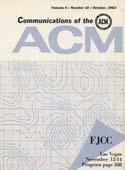October 1963 - Vol. 6 No. 10

Features
Report on proposed American standard flowchart symbols for information processing
This paper presents the essential contents of the Proposed American Standard Flowchart Symbols for Information Processing. This is the first proposed standard prepared by Subcommittee X3.6 on Problem Description and Analysis of the American Standards Association (ASA).
Character addressable, variable field computers permit ready establishment and manipulation of variable width stacks. Single machine commands may push variable field items down into such stacks or pop them up. The availability of a variety of field delimiters allows the machine to push down or pop up more than one variable width item with one command. Since these stacking operations can be made the basis of compiler decoding algorithms, the proper use of machines of this class for compilation has advantages over machines with fixed-length words.
An experiment in automatic verification of programs
How effective is a compiler at replacing explicit verification, and what is the cost of this technique?
Partioning algorithms for finite sets
The partitions of a set with n elements are represented by certain n-tuples of positive integers. Algorithms are described which generate without repetitions the n-tuples corresponding to: (1) all partitions of the given set, (2) all partitions of the given set into m or fewer sets (1 ≨ m ≨ n), and (3) all partitions of the given set into exactly m sets (1 ≨ m ≨ n).
A contour-map program for x-ray crystallography
A FORTRAN program is described for use with the IBM 7090 system and an x, y-plotter to produce a contour map. A matrix of points evenly spaced in each dimension is contoured. Scale factors along the axes may be different and the axes need not be perpendicular.
DATA-DIAL: two-way communication with computers from ordinary dial telphones
An operating system is described which allows users to call up a remotely located computer from ordinary dial telephones. No special hardware or connections are required at the users' telephones. Input to the computer is through the telephone dial; output from the computer is in spoken form. Results of a test with telephones in the Boston area are reported.
An automatic data acquisition and inquiry system using disk files
Lockheed Missiles and Space Company has installed a large-scale Automatic Data Acquisition (ADA) system which ties together the Company's manufacturing facilities located in Van Nuys and Sunnyvale, California. The system includes over 200 Remote Input Stations which collect and transmit Company operating data to a central Data Processing Center. Two RCA 301 EDP Systems are used to record and control the flow of data transmitted to the Data Processing Center. A large capacity RCA 366 Data Disc File is used to store information required to provide up-to-date information in response to inquiries received from remotely located Inquiry Stations. In addition to storage of data on the disk files, the system automatically records all incoming and outgoing data on magnetic tape to be used as input to the Company's conventional off-line business data processing applications.
Use of the disk file on stretch
The paper begins by briefly describing the Stretch (IBM 7030) computer with special emphasis given to the organization and operation of its input-output equipment. Physical characteristics of the two-disk system (4,194,304 72-bit words, 8 µsec-per-word transmission rate, etc.) are noted. Timing limitations due to arm motion and disk rotation are discussed.
Applications of disk usage are discussed separately for problem programs and for systems programs such as compilers and the supervisory program. Approximately 260,000 words of disk storage are reserved for the storage of systems programs and the subroutine library. Problem programs, however, are not currently filed on the disk.
Certain programming techniques are discussed for transmitting words between disk and core storage with minimum delaying and interruption of the arithmetic unit. Dumps on disk are considered for both recovery from computer malfunction and for mathematical or physical developments during the calculation.
A comparison of disks and tapes
The principal characteristics of current magnetic disks and tape units are summarized and compared. Some of the characteristics of disk files are illustrated in a sorting example and compared to a tapesort. The conclusion is presented that disk files are competitive to tapes in some important applications.
An extension of Fibonaccian search to several variables
A technique which uses Fibonaccion search concepts has been developed to solve optimization problems involving unimodal functions of several variables. The technique has not been proven to be optimal in the sense that the one-dimensional Fibonaccion search is. However, it is valuable for certain kinds of calculations.
Computation’s development critical to our society
The ACM's growth continues: we are now at 13,000 members; expenses also grow. Our professional membership does not spring from a uniformly trained group as in mathematics or physics or even economics. Instead, our increasing membership comes from what I might call intellectual adventures—pioneers in an over-organized society—who see great futures in computing at all levels of aspiration.



